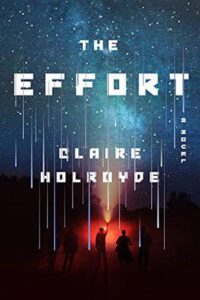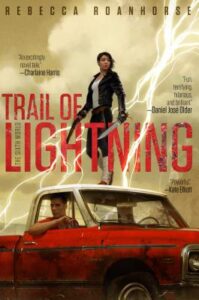The usual killers are easy to spot. They can be uninhabitable, dystopian futurescapes of planet Earth: deserts with salt flats, unbreathable air, or submerged ruins of cities. These settings could become a reality in our lifetimes, but tomorrow’s threats are not always today’s concern. Killers of the present can take the shape of extreme weather: superstorms, tornadoes, and tsunamis. They act like deadly assassins sent by vengeful mother nature—but was she miscast in this role? What if the killers in a climate change/disaster thriller were also the architects of their unsustainable circumstance—us?

The Effort begins when a large comet is spotted on the edge of our blind spot behind the sun. Initial reaction from the public is apathy. Early trajectories calculate a high probability of impact with Earth, but the U.S. government is skeptical and precious reaction time is lost. Scientists struggle to unify nations and pool resources toward a global response named The Defense Effort for Comet UD3, or just The Effort. The comet itself, out in Jupiter’s orbit at the time of discovery, is not directly harmful. However, the existential crisis it inflicts causes a breakdown of modern society. Many people stop functioning normally as they consider The End and all its implications. Supply chains between industrial farming in rural regions and densely populated cities break. Food scarcity is exaggerated by looting, hoarding, and violent raids. From this chaos, heroes and killers emerge.
Heroes in The Effort are plural and diverse. A global disaster requires the very best of us—and the best come in all nationalities, cultures, genders, races, skillsets, creeds, sexualities, etc. At the lead are scientists that have always reached across borders to collaborate for the greater good, and history has shown remarkable results of their collective action. Under the auspices of the United Nations and the European Union, the Effort builds headquarters at a spaceport in French Guiana and begins to assemble an intercept vehicle with a narrow launch window that counts down like a ticking doomsday clock. As the comet becomes visible to amateur telescopes, and then the naked eye, staff at The Effort look to the sky while keeping watch on the much more immediate threat right outside their compound perimeter…people.
The bounty of the natural world has been so greatly diminished in the Anthropocene age, and the survival skills of our ancestors have been forgotten. Hunter/gatherer societies still subsisting by their traditional ways have mostly been wiped out in all but the most unreachable places on the globe: the Arctic and the Amazon. When comet refugees fleeing violence and starvation in the cities ravage rural farmland and pick fields and pastures clean, each of the 7.5 billion humans must decide who they really are after laws and civilization have been stripped away. There is atrocity, but also the beauty of friendship and altruism that are uniquely human.

Killers also pop off the pages of some of my favorite recent climate/disaster fiction. In Trail of Lightning by Rebecca Roanhorse, they serve as a haunting backstory. Most of the world’s population has perished in catastrophic flooding and the Energy Wars that followed. The Indigenous Navajos, or Diné, build the Wall to stay safe from the outside world, but there is too much starvation within. A band of killers surround Maggie Hoskie on the night of her sixteenth birthday. They butcher her grandmother but when they turn on Maggie, her supernatural clan powers awaken as a defensive mechanism. She saves her own life by becoming a killer of killers. Maggie changes, like the rest of the world, into something new entirely. Now an adult, she looks up at the Wall and remembers that her people “had already suffered their apocalypse over a century before. This wasn’t our end. This was our rebirth.”

The killers of The Resistors by Gish Jen are an unseen enemy that run AutoAmerica. Only half of the country is still above the rising sea level. Dry land, jobs, and freedom are given to the upper-class, called the Netted. The lower-class, called the Surplus, are unemployed and must live on Auto-Houseboats gathered in Flotsam Towns. Grant Chastanet, our narrator with copper-toned skin, remarks, “It was, one had to say, quite a coincidence that the underclass looked as it did; groups like AutoAmericans Against Apartheid called it the New Segregation.” The government tries to control and reduce the Surplus population with laws, and permits only one pregnancy per Surplus couple. Other methods are more insidious: free NettieFood is drugged with an unknown barbiturate, playgrounds for Surplus children emanate a chemical that makes them spastic and wobbly. Peeling back the surface of AutoAmerica gives this heart-warming story about resistors forming an underground baseball league greater stakes and more relevance.

A killer and a hero in climate/disaster fiction can even be one in the same. Appleseed by Matt Bell, one of the most original and daring novels of 2021, raises the stakes to humanity’s potential self-destruction. Bell artfully weaves three timelines and multiple incarnations of protagonist John into a complex, epic tale. The middle timeline begins fifty years into our future, after coastal flooding in the East and a massive California earthquake have weakened the American government enough for a takeover by Earthtrust corporation. In a climate where all plants and animals are dead or dying, Earthtrust’s genetically engineered crops and livestock are the only way to feed the global population. Earthtrust is all-powerful and continues to execute plans for its end goal unchecked—but for John. In this timeline, John is John Worth, one of the original founders of Earthtrust. John and four other ex-Earthtrust employees are returning to headquarters in Ohio to destroy what they helped build. John doesn’t want to be a killer or a hero. “Maybe all he can do is keep trying to give the world back to itself, to continue to free whatever he can from the long damage of human want.” The path to redemption exceeds John’s imagination when faced with the choice to kill the whole human race in order to stop our destruction of the planet; death so that there can be life.

















